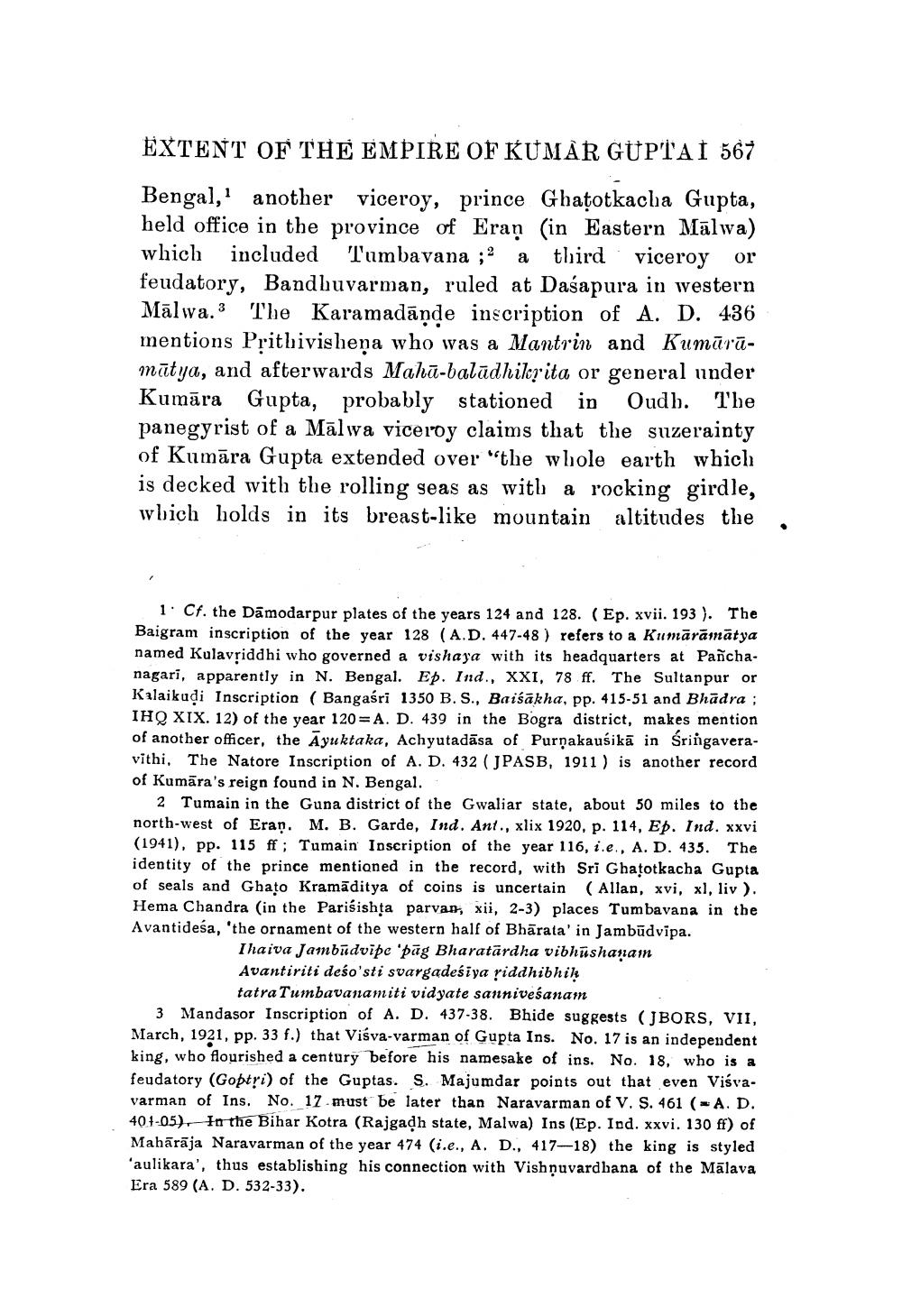________________
EXTENT OF THE EMPIRE OF KUMAR GUPTA I 567 Bengal, another viceroy, prince Ghatotkacha Gupta, held office in the province of Eran (in Eastern Mālwa) which included Tumbavana ;? a third viceroy or feudatory, Bandhuvarman, ruled at Dasapura in western Mālwa.3 The Karamadāņde inscription of A. D. 436 mentions Prithivishena who was a Mantrin and Kumārāmātya, and afterwards Mahū-balādhikrita or general under Kumāra Gupta, probably stationed in Oudh. The panegyrist of a Mālwa viceroy claims that the suzerainty of Kumāra Gupta extended over "the whole earth which is decked with the rolling seas as with a rocking girdle, wbich holds in its breast-like mountain altitudes the
1. Cf. the Damodarpur plates of the years 124 and 128. (Ep. xvii. 193 ). The Baigram inscription of the year 128 (A.D. 447-48 ) refers to a Kumārāmātya named Kulavșiddhi who governed a vishaya with its headquarters at Panchanagari, apparently in N. Bengal. Ep. Ind., XXI, 78 ff. The Sultanpur or Kalaikudi Inscription (Bangasri 1350 B.S., Baisakha, pp. 415-51 and Bhādra ; IHQ XIX. 12) of the year 120= A. D. 439 in the Bogra district, makes mention of another officer, the Ayuktaka, Achyutadāsa of Purnakauśikā in Sringaveravithi, The Natore Inscription of A. D. 432 ( JPASB, 1911 ) is another record of Kumāra's reign found in N. Bengal.
2 Tumain in the Guna district of the Gwaliar state, about 50 miles to the north-west of Eran. M. B. Garde, Ind. Ant., xlix 1920, p. 114, Ep. Ind. xxvi (1941), pp. 115 ff; Tumain Inscription of the year 116, i.e., A. D. 435. The identity of the prince mentioned in the record, with Sri Ghatotkacha Gupta of seals and Ghato Kramāditya of coins is uncertain (Allan, xvi, xl, liv ). Hema Chandra (in the Parisishța parvan, xii, 2-3) places Tumbavana in the Avantideśa, 'the ornament of the western half of Bhārata' in Jambūdvipa.
Ihaiva Jambūdvipe 'pag Bharatārdha vibhushanam Avantiriti deśo'sti svargadesiya riddhibhir
tatra Tumbavanamiti vidyate sanniveśanam 3 Mandasor Inscription of A. D. 437-38. Bhide suggests (JBORS, VII, March, 1921, pp. 33 f.) that Viśva-varman of Gupta Ins. No. 17 is an independent king, who flourished a century before his namesake of ins. No. 18, who is a feudatory (Goptri) of the Guptas. S. Majumdar points out that even Viśvavarman of Ins. No. 17 must be later than Naravarman of V. S. 461 (= A. D. 404-05). In the Bihar Kotra (Rajgadh state, Malwa) Ins (Ep. Ind. xxvi. 130 ff) of Mahārāja Naravarman of the year 474 (i.e., A. D., 417-18) the king is styled ‘aulikara', thus establishing his connection with Vishņuvardhana of the Mālava Era 589 (A. D. 532-33).




